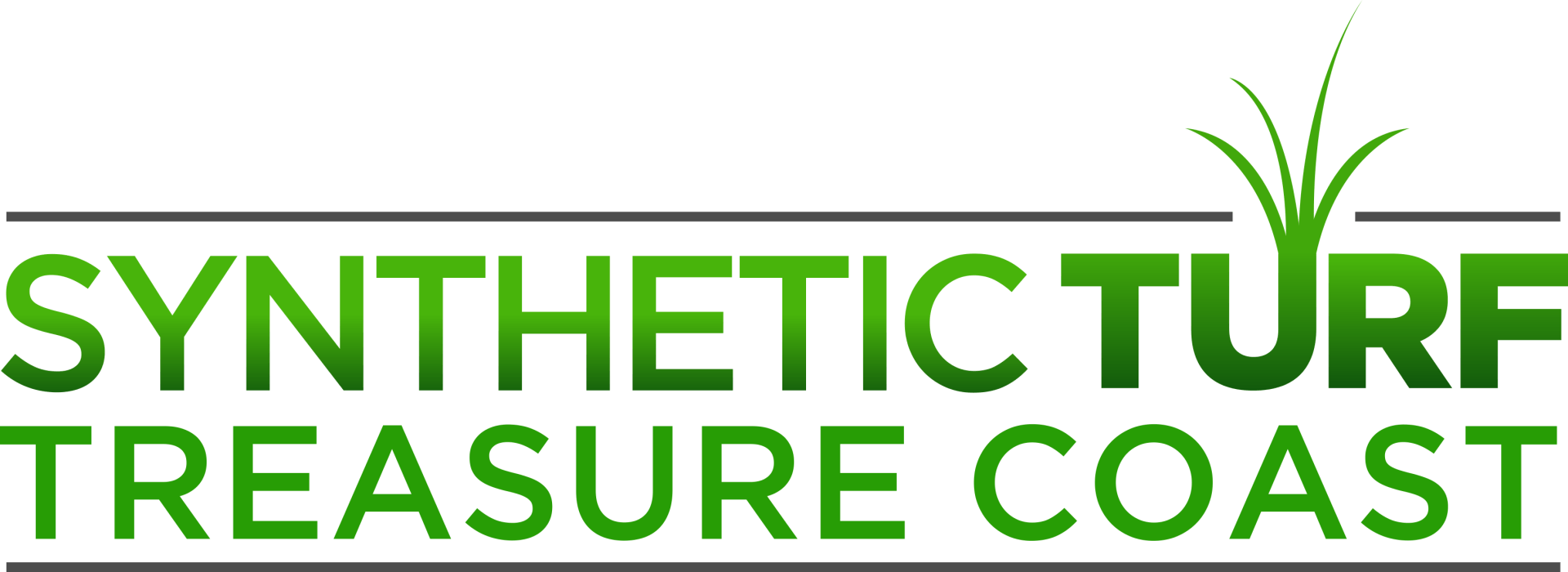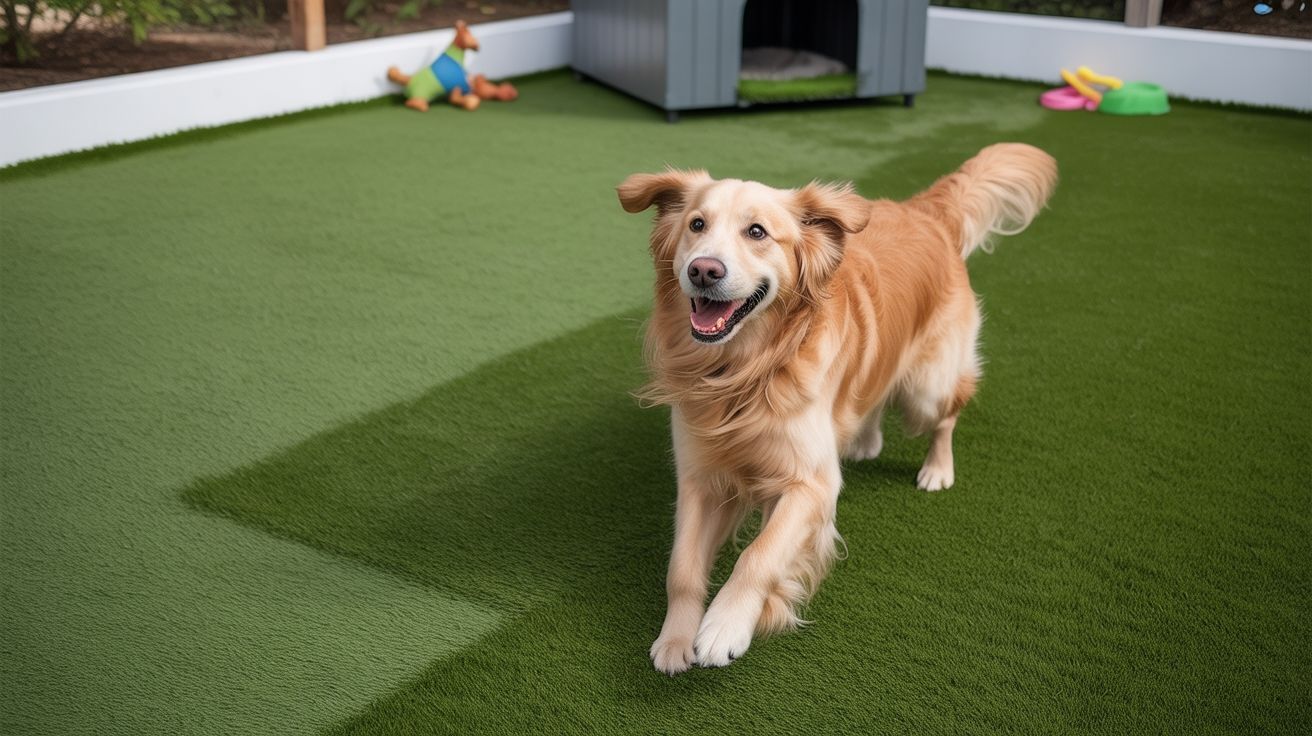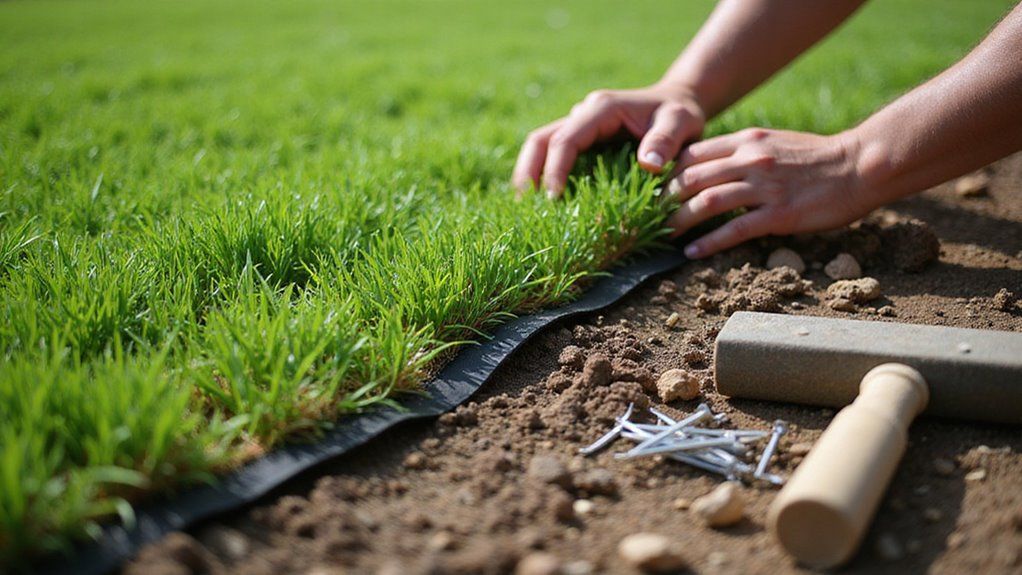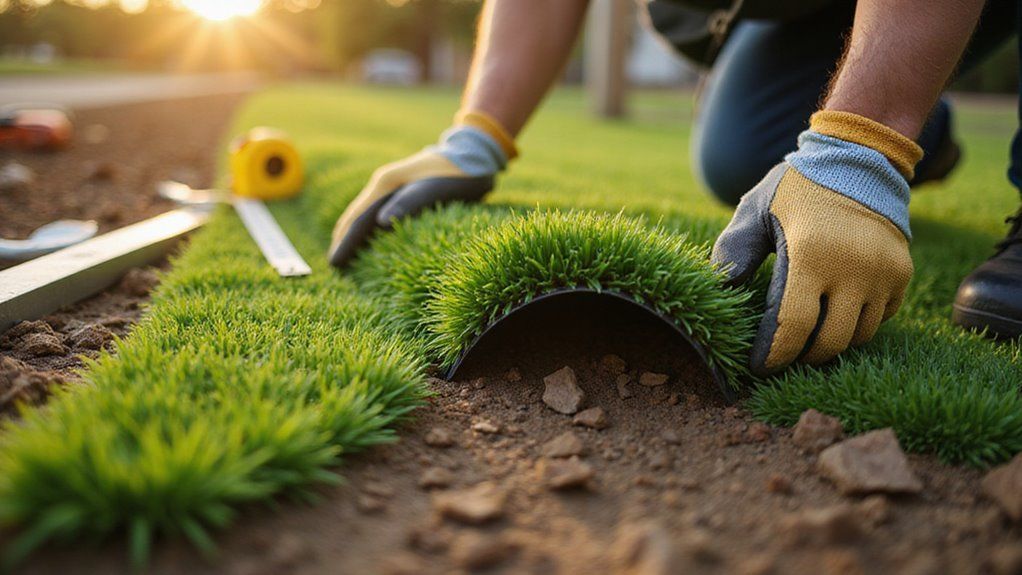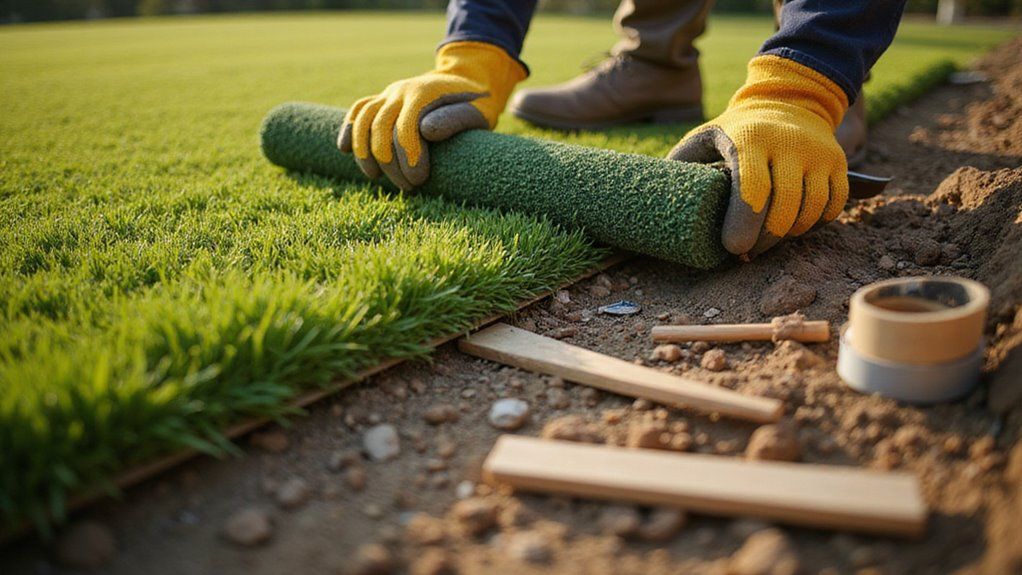What Is the Best Thing to Put Under Artificial Grass?
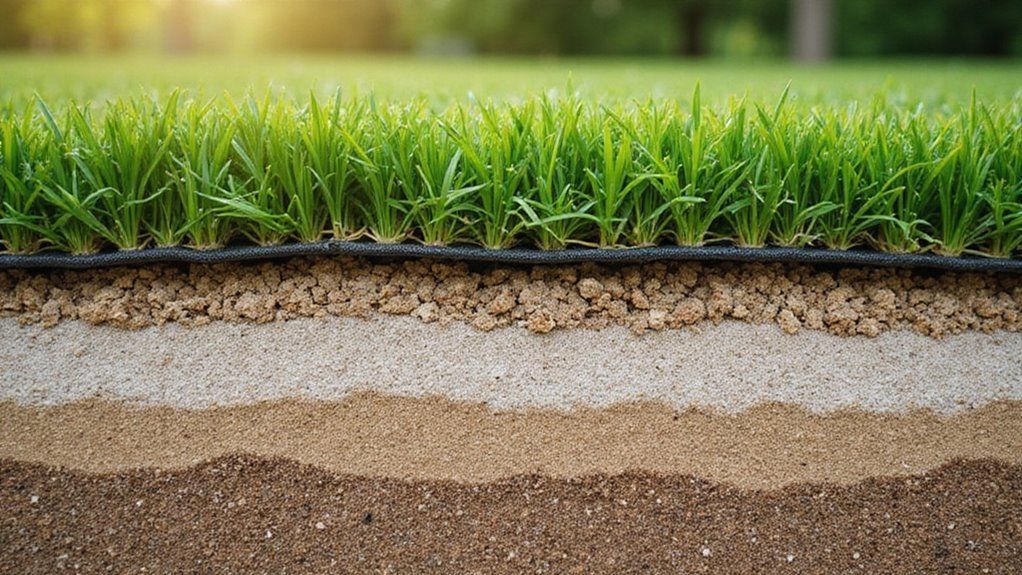
Installing artificial grass seems simple, but what you put underneath is very important. The wrong base can cause drainage issues, uneven surfaces, and a shorter lifespan for your turf. Many people are unsure about the best material to use under artificial grass.
If you pick the wrong base, your lawn might become lumpy or soggy. Poor drainage can lead to water pooling and bad smells. These problems can ruin the look and feel of your artificial lawn.
The best thing to put under artificial grass is a layer of crushed stone or decomposed granite. These materials provide stability, allow for proper drainage, and prevent weeds from growing through your turf.
This blog will guide you step by step so you can choose the right base for your artificial grass.
Key Takeaways
- Crushed stone or decomposed granite bases are industry standards, providing excellent drainage, stability, and a smooth, durable surface for artificial grass.
- A geotextile weed membrane should be installed beneath the base to prevent weed growth while allowing water to drain efficiently.
- For enhanced safety and comfort, especially in play areas or high-traffic zones, add shock pads or rubber underlays on top of the base.
- Drainage mats or geo-grid layers improve water movement, preventing pooling and extending the lifespan of artificial grass installations.
- Proper soil preparation—removing organic material, leveling, compacting, and ensuring correct slope—is essential for a stable and long-lasting artificial grass foundation.
Understanding the Purpose of an Artificial Grass Base
An artificial grass base gives support and stability to the turf above it. If you want your artificial grass to last, you need a strong base underneath. The right base also helps water drain away and stops the surface from becoming uneven.
A good base is usually made from crushed stone or decomposed granite. These materials allow water to pass through easily. If you use the right base, weeds are less likely to grow up through the grass.
For homes and commercial properties in Palm City, FL, using the right base material is a core part of maintenance-free backyards and helps ensure the turf remains low-maintenance and beautiful.
Choosing the proper base keeps your synthetic turf looking neat and level. It also helps the grass stay soft and safe to walk on.
If you care about the environment, a well-built base supports better water management and sustainable landscaping. In addition, factors like proper base preparation—including excavation depth and laying a gravel layer—ensure your artificial grass installation remains durable and resilient over time.
Key Factors to Consider Before Choosing a Base
Before selecting a base for your artificial grass, you’ll need to assess the site’s soil drainage and overall ground stability. Consider how local climate and weather patterns—such as heavy rain or freeze-thaw cycles—can affect long-term performance. By addressing these factors, you’ll ensure a durable, low-maintenance installation.
When planning your base, also account for the importance of consistency in sports fields to optimize playability and safety for all intended activities. Installing a weed barrier is also an important step to prevent unwanted growth and preserve the integrity of your artificial turf base.
Soil Drainage and Stability
Artificial grass needs a strong and stable base to last long. Soil drainage and stability are important for a good foundation. If the soil is weak, the turf may shift or settle unevenly.
Compacted soil helps prevent bumps and dips in the surface. Poor drainage can cause water to pool and damage the grass. If water stays on your lawn after rain, you should check the soil’s permeability.
Tree roots or tough plants can push through and damage the base. A root barrier is essential if you have nearby trees. Proper preparation helps your artificial grass stay smooth and firm.
Climate and Weather Impact
Artificial grass bases need to match your local climate for best results. Weather affects drainage, stability, and turf performance. Choosing the right base prevents problems like water pooling or ground movement.
In rainy areas, use crushed stone or granite dust for good drainage. Freezing climates require a frost-resistant base to stop the ground from shifting. Hot regions benefit from materials that do not trap heat.
If your area has extreme weather, always check local weather patterns before choosing materials. Proper base selection makes your artificial grass last longer and perform better. Using weather-resistant materials helps your turf handle temperature changes and moisture.
Crushed Stone: The Most Popular Base Material
You’ll find that crushed stone is the industry standard for artificial grass bases because it offers superior drainage and long-term stability. Make sure you compact each layer thoroughly and use the right aggregate size—typically 3/4" minus—for optimal performance.
Regularly inspect and re-level the base if settling occurs to maintain a smooth, even surface. By using a crushed stone base, you also help conserve water resources since proper drainage eliminates the need for excessive watering. Choosing a crushed stone base also supports low-maintenance solutions, ensuring your artificial turf stays even and looks great with minimal upkeep.
Drainage and Stability Benefits
Crushed stone is the best base for artificial grass because it improves drainage and stability. It lets water pass through quickly and supports the turf above. This helps keep your lawn looking good for a long time.
Crushed stone is made of small, sharp rocks like granite or limestone. If you use this material, water will not pool on the surface. It also stops the ground from shifting when people walk or place objects on the turf.
The compacted stone forms a strong and even base. If you want to prevent weeds, this layer makes it hard for them to grow. Your artificial grass will stay neat and tidy with this method.
Installation and Maintenance Tips
Crushed stone helps artificial grass drain well and stay stable. If you install it correctly, your turf will last longer. Always start by digging out 3-4 inches of soil and removing any plants or roots.
The subgrade must be compacted to stop future sinking. Lay down a layer of ¾-inch angular gravel for good support. Compact the gravel with a plate compactor to make a flat, even surface.
After placing the turf, brush silica sand into the fibers to keep them upright. Regular checks can spot dips or bumps early. Add more base material or compact again if you find uneven spots.
Proper care keeps your turf looking good and lasting longer. If you maintain it, your artificial grass will perform well for years.
Benefits of Decomposed Granite Under Turf
Decomposed granite is a good base for artificial turf. It offers great drainage, stability, and compaction. If you use it, your turf will last longer.
This material lets water pass through quickly, so puddles are less likely. It also helps prevent mold from growing under the turf. Good drainage keeps your lawn clean and dry. Many artificial turf installers in Tequesta, FL recommend decomposed granite because it is effective at supporting proper drainage and long-term turf health.
Decomposed granite stays in place and does not shift easily. If you want a level turf surface, this is important. The turf remains smooth even with heavy use.
The fine particles of decomposed granite compact well. It forms a firm base that can support frequent foot traffic. If you need a strong and durable foundation, this is a smart choice.
For those looking to achieve a lush, low-maintenance lawn affordably, using decomposed granite as a base is both practical and cost-effective.
Sand as a Base: Pros and Cons
Sand is often used as a base for artificial grass because it is easy to work with. It helps create a smooth, level surface and is cost-effective. Sand also allows some water to drain through.
If you use sand, be aware it can shift over time. This may cause uneven spots or wrinkles in your artificial grass. Sand is less stable than other base materials, especially when compared to durable backing material designed specifically for artificial lawns.
Weeds may grow through the sand if it is not treated properly. Sand can also move on slopes or in high-traffic areas. For low-use areas, sand may work well as a base.
If you want long-term durability, consider other materials. You should weigh the pros and cons before choosing sand as your base.
Using sand as a base can contribute to overall resource use through long-term material efficiency in your landscaping project.
Using Gravel for Drainage and Stability
Gravel is a top choice for drainage and stability under artificial grass. It lets water pass through easily and keeps the turf dry. Gravel also creates a strong foundation that supports your lawn. You must compact the soil before and after adding gravel.
If you skip this step, the surface may become uneven over time. A well-leveled base helps artificial grass sit evenly and look neat. For added durability in high-traffic areas, specific blade shapes and proper base selection are both essential. If you want the best results, use angular, crushed gravel.
This type offers better drainage and holds its shape well. Proper gravel selection can help your artificial lawn last longer. In addition to stability, choosing gravel as a base helps minimize pollution and supports an eco-friendly landscaping solution.
Concrete and Asphalt Subsurfaces: When to Use Them
You can often install artificial grass over concrete or asphalt without removing them. These surfaces offer a stable and even base, saving you time and money.
This method is useful when you want to avoid digging or building a new base. Just as Jonathan Dickinson State Park's trails provide a strong foundation for visitors to explore diverse landscapes, a proper subsurface gives your artificial grass the stability it needs.
Drainage is very important with hard surfaces. If water cannot drain, it may cause damage or shorten the turf’s life. Make sure the surface slopes so water can flow away.
A shock pad or drainage mat should be added on top of concrete or asphalt. These layers help with comfort and channel water away from the grass. This setup is ideal for patios, rooftops, or busy play areas.
Concrete and asphalt may not look as natural as soil or grass. If you want a more natural appearance, consider your options before choosing this method. Always match the base to your needs and design goals.
For maximum safety, it’s recommended to monitor and remove hazardous chemicals during installation and maintenance, just as you would with other artificial turf applications.
Geotextile Weed Membranes: Extra Protection
Geotextile weed membranes give extra protection by stopping weeds from growing under artificial grass. These membranes act as a barrier but still let water and nutrients pass through. If you want to keep your turf clean, use a geotextile fabric under the base layer.
Weed barriers work well for reducing unwanted plant growth. They can save you time on maintenance if you install them before laying grass. Water will drain easily, so you will not get puddles or root rot.
Geotextile membranes are strong and resist tearing, even under heavy use. They last a long time, staying in place despite ground movement. If you choose a good-quality fabric, your artificial lawn will stay neat and tidy.
For inspiration on environmental stewardship, you might also consider how habitat exploration programs help educate the community about natural ecosystems and conservation.
Shock Pads for Safety and Comfort
Shock pads are important for making artificial grass safer and more comfortable. These pads are placed under the turf to reduce injuries from falls. They are ideal for places where children play or many people walk.
Most shock pads are made from foam or polyethylene. If you install artificial grass in a busy area, you should use shock pads. These pads help absorb impact and keep the surface even.
A strong and level base is still necessary before adding shock pads. If you prepare the ground well, your artificial grass will last longer. Shock pads can increase comfort and improve safety ratings for your turf.
Rubber Underlays for Playgrounds and Sports Areas
When you're installing artificial grass for playgrounds or sports areas, rubber underlays provide critical impact absorption and improved safety. You'll also benefit from built-in drainage channels and long-term durability that withstands heavy foot traffic.
Choosing the right rubber underlay ensures compliance with fall height standards and maximizes surface performance.
Enhanced Safety and Cushioning
Enhanced Safety and Cushioning
Proper underlay is important for making artificial grass safe and comfortable. Rubber underlays are often used for playgrounds and sports areas. They help to prevent injuries from falls.
Rubber underlays absorb shock when someone falls. If you want to meet playground safety standards, you should use these underlays. They provide a soft cushion without making the surface unstable.
These underlays also keep the ground even and smooth. If the ground stays even, play is safer and more enjoyable. They also help reduce noise in busy areas.
Drainage and Durability Benefits
Rubber underlays help water drain quickly from artificial grass. This prevents puddles and keeps the area from flooding. Good drainage is key for safe and long-lasting playgrounds and sports fields.
If you use a rubber underlay, the base under the grass will not get packed down or damaged as easily. This means the artificial grass will last longer. High-traffic areas especially benefit from this extra protection.
Proper drainage also helps keep the landscape in good shape. If water collects, it can damage both the grass and the ground below. Rubber underlays are a simple way to avoid these problems.
Foam Pads for Balconies and Rooftop Installations
Foam pads are important when installing artificial grass on balconies and rooftops. They give extra comfort and help water drain properly. These pads also protect the surface beneath the grass and help it last longer.
People should choose foam pads that keep the grass looking good and support eco-friendly options. This helps your project look neat and supports green building goals.
Foam pads work well because they absorb impact, making the area safer for walking or playing. Built-in channels move water away to prevent puddles. They also help block heat, protecting both the roof and waterproof layers.
How to Prepare Soil Before Laying Artificial Grass
To prepare soil before laying artificial grass, ensure the ground is stable and clean. Remove all turf, weeds, and rocks from the area. Check that the ground is level and slopes away from buildings for drainage.
Excavate the soil to a depth of 3 to 4 inches. Take out all plant roots and organic material to prevent bumps and weed growth. If the ground is loose or sandy, add crushed stone or granite dust.
Compact the soil using a plate compactor for a firm base. If you notice low spots, fill them and compact again. Proper preparation helps your artificial grass last longer and look better.
Drainage Solutions for Wet or Flood-Prone Areas
If you're working in a wet or flood-prone area, you'll need to prioritize drainage beneath your artificial grass.
Choose permeable base materials like crushed stone or gravel to promote rapid water movement away from the surface. For even better performance, consider installing a drainage mat system to further prevent pooling and protect your turf installation.
Permeable Base Materials
Permeable base materials help keep artificial grass stable and mud-free during heavy rain. These materials allow water to drain quickly, which prevents pooling and flooding. Good drainage is essential for the long-term health of your turf.
Crushed granite is a strong choice because it drains well and compacts tightly. Washed angular gravel also works well, as its uneven shapes create spaces for water to pass through. Recycled crushed concrete is an eco-friendly option that supports drainage and weight.
If you live in a wet area, pick a base that drains water easily. The right material will keep your yard dry and your artificial grass looking good. Proper base selection protects your landscape all year.
Drainage Mat Installation
Drainage mats help move water away from synthetic turf. These mats are important if your yard gets heavy rain or does not drain well. Install a drainage mat to prevent water from pooling under your turf.
Place the drainage mat on top of the compacted base before you lay the turf. Make sure the mat channels water toward drains or runoff areas. This step keeps your turf dry and safe.
There are different types of drainage mats. Flat panel mats work well for most home lawns. Cup-style and geo-grid mats handle more water, so use them for wet areas or sports fields.
Maintenance Tips for a Long-Lasting Artificial Lawn Base
Maintaining your artificial lawn base helps it last longer and work better. If you care for the base, you avoid common problems like uneven spots or poor drainage. Regular checks can save you money and keep your lawn looking good.
You should inspect the base for dips or soft patches. If you find any, add more crushed stone or granite and pack it down well. A firm base prevents uneven surfaces.
Remove leaves, weeds, and other debris as soon as you see them. Keeping the base clean stops weeds from growing and helps water drain properly. Clean areas will also look more attractive.
Check for puddles after it rains. If you see water collecting, you may need to level out the base again. Fixing drainage issues quickly stops further damage.
Conclusion
If you want your artificial grass to last, you should choose the right base material. Crushed stone or decomposed granite with a weed barrier works much better than plain soil or sand. A solid base helps your turf stay level and drains water efficiently.
If you skip proper preparation, your turf may shift or develop drainage problems. When you invest in professional installation, your lawn will look better and last longer. Simple steps like layering and using modern materials make a big difference.
If you want the best results, choose experts who use quality techniques and materials. Install your artificial grass with Synthetic Turf Treasure Coast for a beautiful, long-lasting lawn. Contact them today to get started on your project.
About the author
Kathy Leavell
Kathy Leavell is the founder and owner of Synthetic Turf Treasure Coast, a leading provider of synthetic grass solutions for residential and commercial properties in Florida. With over a decade of experience in the industry, Kathy has become a recognized expert in synthetic turf installation, maintenance, and repair. Under her leadership, Synthetic Turf Treasure Coast has earned a reputation for exceptional customer service and high-quality workmanship.
Prior to starting her own business, Kathy worked in sales and marketing roles at several major synthetic turf manufacturers.
